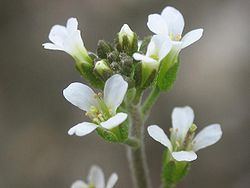Higher classification Cabbage family | Scientific name Arabidopsis Rank Genus | |
 | ||
Lower classifications Thale cress, Arabidopsis lyrata, Arabidopsis arenosa | ||
Elliot meyerowitz caltech hhmi 2 plant development modeling arabidopsis phyllotaxis
Arabidopsis (rockcress) is a genus in the family Brassicaceae. They are small flowering plants related to cabbage and mustard. This genus is of great interest since it contains thale cress (Arabidopsis thaliana), one of the model organisms used for studying plant biology and the first plant to have its entire genome sequenced. Changes in thale cress are easily observed, making it a very useful model.
Contents
- Elliot meyerowitz caltech hhmi 2 plant development modeling arabidopsis phyllotaxis
- A lecture in plant biology control of arabidopsis root development
- Status
- A thaliana in partial in vitro conditions
- List of species and subspecies
- Cytogenetics
- Reclassified species
- References
A lecture in plant biology control of arabidopsis root development
Status
Currently, the genus Arabidopsis has nine species and a further eight subspecies recognised. This delimitation is quite recent and is based on morphological and molecular phylogenies by O'Kane and Al-Shehbaz (1997, 2003) and others.
Their findings confirm the species formerly included in Arabidopsis made it polyphyletic. The most recent reclassification moves two species previously placed in Cardaminopsis and Hylandra and three species of Arabis into Arabidopsis, but excludes 50 that have been moved into the new genera Beringia, Crucihimalaya, Ianhedgea, Olimarabidopsis, and Pseudoarabidopsis.
All of the species in Arabidopsis are indigenous to Europe, while two of the species have broad ranges also extending into North America and Asia.
In the last two decades, Arabidopsis thaliana has gained much interest from the scientific community as a model organism for research on numerous aspects of plant biology. The Arabidopsis Information Resource (TAIR) is a curated online information source for Arabidopsis thaliana genetic and molecular biology research, and The Arabidopsis Book is an online compilation of invited chapters on Arabidopsis thaliana biology. In Europe, the model organism resource centre for Arabidopsis thaliana germplasm, bioinformatics and molecular biology resources (including GeneChips) is the Nottingham Arabidopsis Stock Centre – NASC whilst in North America germplasm services are provided by the Arabidopsis Biological Resource Center, (ABRC) based at the Ohio State University. The ordering system for ABRC was incorporated into The Arabidopsis Information Resource (TAIR) database in June 2001 whilst NASC has always (since 1991) hosted its own ordering system and genome browser.
Starting with a Kickstarter in 2013, Arabidopsis has had genes for luciferin and luciferase inserted to create a strain of "Glowing Plant" Arabidopsis set to be commercially distributed approximately in 2016.
A. thaliana in partial in vitro conditions
Recently, A. thaliana tissues have been cultivated in microfluidic devices. Plant-on-chip devices show promise for future research in understanding the mechanism of sexual reproduction in A. thaliana.
List of species and subspecies
Cytogenetics
Cytogenetic analysis has shown the haploid chromosome number (n) is variable and can be 5, 8 and 13.
A. thaliana is n=5 and the DNA sequencing of this species was completed in 2001.
A. suecica is n=13 (5+8) and is an amphidiploid species originated through hybridization between A. thaliana and diploid A. arenosa.
A. neglecta is n=8, as are the various subspecies of A. halleri.
Various subspecies of A. lyrata and A. arenosa can be either 2n (diploid) or 4n (tetraploid).
As of 2005, A. cebennensis, A. croatica and A. pedemontana have not been investigated cytologically.
Reclassified species
The following species previously placed in Arabidopsis are not currently considered part of the genus.
